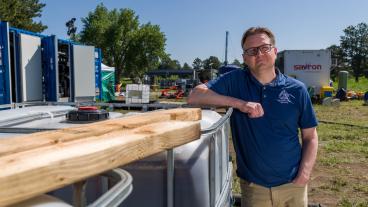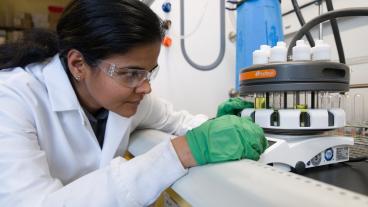Inhalable 'bots' offer potential treatment for cystic fibrosis
Inhalable “microbots” under development at Colorado School of Mines could be used to help treat cystic fibrosis, a chronic and progressive genetic disease that causes severe damage to the lungs and other organs.
David Marr, professor of chemical and biological engineering, and Keith Neeves, associate professor of chemical and biological engineering, have been awarded $418,000 from the National Institutes of Health’s National Institute of Allergy and Infectious Diseases to develop magnetically powered blood cell-sized microwheels, or microbots, especially suited for treating medical issues in the lungs such as cystic fibrosis.
The duo has already been working on applications of their drug-delivering microbots in the treatment of strokes, particularly in vessels too small to be accessed through traditional catheterization, recently receiving $2.6 million in funding from the NIH's National Institute of Neurological Disorders and Stroke to further develop the technology.
With this new infusion of NIH funding, the goal is to take advantage of the microbots’ small size to use airborne delivery and inhalation into the lungs to combat infections that are difficult to treat by other means, Marr said.
“We could both deliver drugs, as in the stroke application, and use the mechanical aspects of rotating microbots, also like the stroke application, to dig through what’s known as the extracellular matrix to help destroy biofilms associated with cystic fibrosis,” Marr said.
A variety of diseases are directly associated with biofilms, including cystic fibrosis, bronchiectasis, periodontitis, infections associated with catheters, chronic sinus infections and even contact lens fouling. Their treatment costs tens of billions of dollars every year, due in large part to how difficult it is to remove biofilms, caused by the associated exopolysaccharide (EPS) matrix, a natural polymer layer, that hinders diffusion of drugs to underlying bacteria.
In cystic fibrosis specifically, a defective gene causes thick, sticky mucus to build up in the lungs, pancreas and other organs. In the lungs, that mucus clogs the airways and traps bacteria, leading to infections, lung damage and, eventually, respiratory failure. More than 30,000 Americans are currently living with cystic fibrosis.
“The basic idea is that the building blocks of the microbots — which contain antibiotics and dispersal agents — are inhaled into the lungs and then assembled in place with an applied magnetic field,” Marr said. “Once they’re in there, they’ll work to break up mucus in an effort to eradicate those biofilms.”
The funding will allow researchers to test the microbots on biofilms derived from cystic fibrosis patient samples, as well as use 3D physical models of human airways to determine how to best assemble and move the microbots to degrade the biofilms and kill bacteria faster than soluble dispersants and antibiotics alone.
Aiding these investigations is Emily DeBoer, assistant professor of pediatrics at the University of Colorado Anschutz Medical Campus and a clinician in pediatric pulmonology. DeBoer has experience in both treating cystic fibrosis patients and the creation of 3D airway models that will allow the team to test microbot efficacy.




